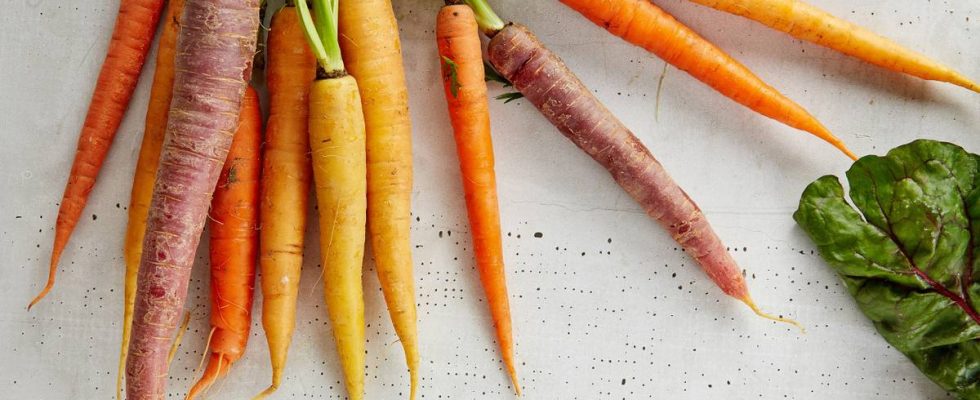Raw meat, raw fish, raw eggs, raw milk products – all supplemented by cold-pressed juices and unheated honey: anyone who can survive such a diet without any problems must be blessed with a horsey nature. Horses are actually herbivores.
Read more after Advertisement
Read more after Advertisement
Always wash lettuce thoroughly
The inventor of this diet was the American Aajonus Vonderplanitz (1947–2013). He called it the “primal diet.” He attributed the potential to cure all sorts of diseases to raw foods, especially in the form of animal products. The German non-fiction author Franz Konz (1926–2013) also saw salvation in raw food after suffering from cancer: his concept of “primal food” envisages eating unwashed fruit, vegetables and wild plants, including worms and all microorganisms.
Read more after Advertisement
Read more after Advertisement
When it comes to tips like these, nutrition experts throw up their hands. From a hygienic point of view, raw animal products are questionable. “They can be contaminated with salmonella or listeria, for example,” says nutritionist Ursula Leyendecker-Bruder from Cologne. Foodborne infections can be dangerous for pregnant women, small children, seniors and people with weakened immune systems. But pathogenic germs can also stick to raw fruit and vegetables. Nutritionist Gabriele Kaufmann from the Federal Center for Nutrition (BZfE) therefore emphasizes: “Even if the lettuce comes from your own garden, you should wash it thoroughly.” For example, insects that have sat on it could transmit pathogens.
Integrate raw food into your diet plan
But there are completely other reasons that speak against raw food diets. A few years ago, a study by the University of Giessen showed that people who lived largely on raw fruit and vegetables for a long time tended to suffer from nutrient deficiencies. They were often undersupplied with vitamin B12, but also with vitamin D, zinc, iodine and calcium. At the same time, they were mostly slim to underweight.
“With such a diet you run the risk of consuming too little energy,” says Leyendecker-Bruder. A pure raw food diet also eliminates grain products such as pasta and bread, which provide a lot of energy. However, many people benefit from incorporating more raw foods into their diet. It can help control your weight: If you nibble carrot sticks instead of potato chips in front of the TV, you avoid fatty and salty calorie bombs. But you shouldn’t expect too much from raw food snacks, warns Kaufmann: “If you want to lose weight in a balanced and long-term way, you should seek professional advice.”
Steaming is gentler than boiling
Raw fruits and vegetables are usually healthy, but not always. As a rule, you consume more vitamins and phytochemicals because some of them are destroyed when heated. Vitamin C in particular is sensitive not only to heat, but also to light and oxygen and cannot be stored by the body. Most B vitamins and some phytochemicals, which have positive effects on health, also do not withstand high temperatures.
Read more after Advertisement
Read more after Advertisement
How much the nutrient content decreases during preparation depends on the type of vegetable and the method of preparation. In principle, steam cooking or short blanching is gentler than longer cooking. Heat cannot harm minerals, but they can dissolve in the cooking water.
Cook lentils, beans and chickpeas
Conversely, some nutrients are better utilized when vegetables are heated. “The body can only absorb beta-carotene from carrots and lycopene from tomatoes when the cell walls are broken down by cooking,” says Leyendecker-Bruder. Both substances are carotenoids, which have many positive effects.
There are also plants that should not be eaten raw, especially legumes. “The lectins in it are incompatible and, in the worst case, can cause symptoms of poisoning,” explains Leyendecker-Bruder. These proteins can cause red blood cells to clump together and are dangerous in large quantities. “You should definitely not eat lentils, beans and chickpeas raw,” advises the nutritionist. Since heat destroys the poison, it is important to cook legumes for at least 15 minutes. Peas and snow peas are a special case: they hardly contain any lectins.
Read more after Advertisement
Read more after Advertisement
Be careful with wild mushrooms
Potatoes should also be cooked. Their high starch content makes them difficult to digest, as Leyendecker-Bruder explains. Only when exposed to heat is the starch converted so that the body can process it well. Like other nightshade plants, potatoes also contain solanine, which in large quantities can lead to symptoms of poisoning. The substance is found in higher concentrations, especially in green and sprouting potatoes. Therefore, you should cut out green areas and germination before cooking. According to consumer advice centers, heat does not destroy solanine, but cooking causes the substance to partially dissolve in water. That’s why you should throw it away afterwards.
You should also be careful with wild mushrooms. Mushroom experts recommend cooking them well for at least 15 minutes. There are several reasons for this: Some species, such as pearl mushroom and honey mushroom, contain poisons that are destroyed by heating. In addition, the difficult-to-digest protein in wild mushrooms becomes more digestible when cooked.
Cooking vegetables makes them easier to digest
Other foods are not poisonous when uncooked, but they are also difficult to digest. Raw grain, for example, can cause severe stomach pain – unless it has been soaked for a long time. Cabbage is just as borderline: “Some types of cabbage, such as broccoli, can be eaten raw. Basically, it is cooked but is easier to digest,” says Leyendecker-Bruder.
Read more after Advertisement
Read more after Advertisement
“The longer vegetables or fruit are cooked, the more digestible they become,” emphasizes BZfE expert Kaufmann. Which vegetables are well tolerated raw varies from person to person. However, to a certain extent, even sensitive stomachs can get used to raw food by carefully increasing the quantities and chewing carefully. The German Nutrition Society recommends eating fruits and vegetables sometimes cooked and sometimes raw. In the end, it’s the mixture that counts.

